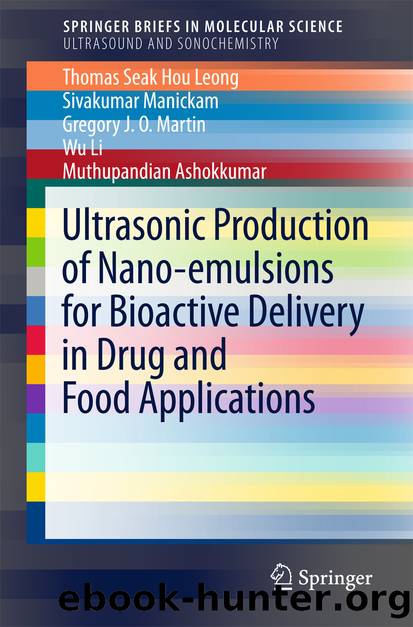Ultrasonic Production of Nano-emulsions for Bioactive Delivery in Drug and Food Applications by Thomas Seak Hou Leong Sivakumar Manickam Gregory J. O. Martin Wu Li & Muthupandian Ashokkumar

Author:Thomas Seak Hou Leong, Sivakumar Manickam, Gregory J. O. Martin, Wu Li & Muthupandian Ashokkumar
Language: eng
Format: epub
Publisher: Springer International Publishing, Cham
Emulsifier
HLB
Saturated and unsaturated mono/diglycerides
3–4
Propylene glycol esters
3.5
Sorbitan monostearate
4.7
Lecithin
4–9
Polyglycerol esters of fatty acids
7
Cellulose gums
10–11
Polysorbate 65
11.0
Sucrose esters
11–15
Polysorbate 60
14.5
Polysorbate 80
15.0
Sodium stearoyl lactylate
21.0
HLB values sourced from [47]
2.6 Influence of Continuous Phase Viscosity
The viscosity of the continuous phase influences the overall stability of the dispersed phase. Increasing the continuous phase viscosity reduces the mobility of the dispersed droplets, slowing down inter-droplet collisions that may lead to droplet coalescence, and slows the rate of creaming. For some systems, it can be purposefully elevated to improve EDS reduction efficiency [23] and long-term stability. This is usually achieved by the addition of agents known as ‘stabilizers’ [23]. Stabilizers should not be confused with emulsifiers. Although these macromolecules are surface active, they are not used to provide direct inter-droplet emulsion stability through steric/electrostatic effects, but added as a co-surfactant to increase the viscosity of the continuous phase. Commonly used stabilizers suitable for food-grade emulsions include polyethylene glycol (PEG) and hydrocolloid gums such as xanthan gum, locust bean gum and carrageenan.
It should be noted that the viscosity of the continuous phase will affect the onset of acoustic cavitation, as the formation of ‘cavities’, i.e. nucleation of bubbles from ultrasonication, becomes more difficult with higher viscosity. Bubble collapse in high viscosity fluids does however tend to be more intense due to enhanced inertia of the bubble motion [48].
Download
This site does not store any files on its server. We only index and link to content provided by other sites. Please contact the content providers to delete copyright contents if any and email us, we'll remove relevant links or contents immediately.
The Poisoner's Handbook by Deborah Blum(2094)
Bottle of Lies by Katherine Eban(1764)
Mycelium Running: How Mushrooms Can Help Save the World by Paul Stamets(1642)
The Vaccine Race by Meredith Wadman(1629)
Missing Microbes by Martin Blaser(1555)
The Doors of Perception and Heaven and Hell by Aldous Huxley & Aldous Huxley(1549)
Pharmacy Practice and The Law by Richard Abood(1544)
Decisive by Chip Heath(1520)
28 Seconds by Michael Bryant(1489)
Steroids: History, Science, and Issues by Standora Joan E.; Bogomolnik Alex; Slugocki Malgorzata(1480)
McGraw-Hill Nurses Drug Handbook by Patricia Schull(1466)
The Doors of Perception: Heaven and Hell (thINKing Classics) by Aldous Huxley(1452)
Ganja Yoga by Dee Dussault(1427)
What's Making Our Children Sick? by Michelle Perro(1385)
Complete Guide to Prescription & Nonprescription Drugs 2014 by H. Winter Griffith(1329)
Stealing Fire: How Silicon Valley, the Navy SEALs, and Maverick Scientists Are Revolutionizing the Way We Live and Work by Steven Kotler & Jamie Wheal(1310)
Anatomy of an Epidemic by Robert Whitaker(1293)
Trip by Tao Lin(1265)
Cannabis for Chronic Pain by Rav Ivker(1202)
